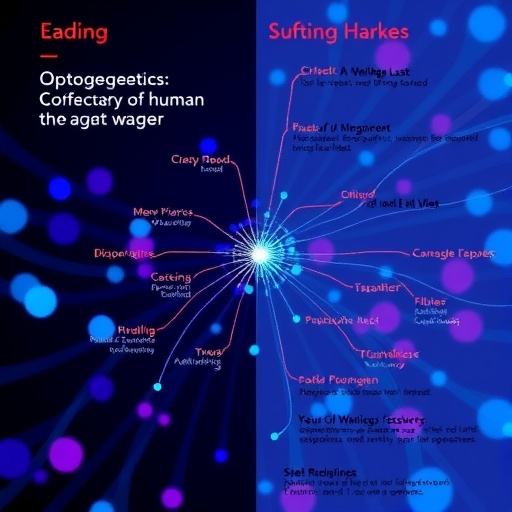Optogenetics has long been celebrated as a revolutionary technique in neuroscience, offering unparalleled precision in controlling and understanding neural circuits. Now, a transformative roadmap has emerged, delineating how the insights derived from optogenetics can be directly and indirectly translated into human therapies. This exciting frontier not only promises new treatments but reshapes our very conception of intervention in brain disorders.
At the heart of this roadmap lies a powerful realization: while optogenetics traditionally excels in basic research, its true clinical potential extends far beyond the laboratory. By using light to manipulate genetically targeted neurons, scientists have unveiled causal relationships between specific cell types and complex behaviors. This has paved the way for innovative therapeutic strategies that extend from direct clinical applications to broader treatment modalities informed by optogenetic discoveries.
One stunning proof-of-principle study has ignited optimism by demonstrating that optogenetics can be applied directly to the human central nervous system to restore vision in cases of blindness. This milestone shines a bright light on the curative possibilities inherent to optogenetic interventions. However, it also compels researchers, clinicians, and bioethicists to ponder deeply the ethical dimensions of such interventions. Careful deliberation is required to ensure safety, consent, and equitable access in future clinical applications.
The roadmap outlines a multi-faceted approach to the translation process. One crucial component is the thoughtful selection of clinical indications where optogenetic tactics could have maximal impact. Diseases involving well-defined neural circuits, such as certain forms of blindness or motor disorders, present primary targets. These disorders provide a more manageable neural landscape for optogenetic modulation, thereby optimizing therapeutic efficacy while minimizing risks.
Another significant pillar of this translation effort is the advancement of molecular and optical strategies designed to achieve cell-type specificity. The ability to precisely target and control specific subsets of neurons without affecting surrounding cells remains a central technical challenge. Innovations in viral vector engineering, promoter specificity, and light delivery systems are all part of the ongoing quest to refine this specificity.
Safety considerations represent yet another vital aspect. Direct optogenetic interventions in humans require rigorous evaluation of gene delivery vectors, immunogenicity, long-term expression stability, and phototoxicity. Regulatory frameworks must adapt swiftly to these novel challenges, balancing the promise of transformative therapies against the imperatives of patient safety and ethical responsibility.
Moreover, the indirect translation of optogenetic findings into other neuromodulatory treatments is equally crucial. By elucidating the causal roles of distinct circuits, optogenetic research guides the development of pharmacological agents, electrical stimulation protocols, and other non-optical interventions. Such indirect pathways can accelerate therapeutic innovation without the immediate need for genetic modification or invasive light delivery.
A significant discussion within the roadmap focuses on the convergence of neuroscience, bioengineering, and clinical disciplines. Progress demands collaboration across these fields to integrate cutting-edge optical hardware with molecular biology and patient care. Multidisciplinary teams are essential to navigate the complex landscape of translating optogenetic science into viable therapies.
Ethical discourse is embedded throughout the translation roadmap. The promise of manipulating brain function at the cellular level raises profound questions about identity, agency, and the nature of intervention. Transparency with patients, robust informed consent processes, and frameworks for addressing unforeseen consequences are foundational to responsible clinical translation.
Notably, the optical tools utilized in optogenetics must overcome significant hurdles before widespread human application. Issues such as light penetration depth, potential heating effects, and device miniaturization remain active areas of research. The roadmap proposes innovative photonic materials and interfacing technologies to surmount these barriers, envisioning seamless integration of optical control mechanisms with human neurophysiology.
Furthermore, patient selection criteria will need thoughtful refinement. Understanding individual variability in neural circuit architecture, disease progression, and genetic background is paramount for designing personalized optogenetic therapies. Advancements in imaging and biomarker discovery will facilitate precision medicine approaches, ensuring that each patient receives a tailored intervention with optimized outcomes.
The roadmap also highlights the importance of ongoing preclinical models that better mimic human brain complexity. Translational research must bridge the gap between rodent or in vitro studies and human application, employing non-human primate models and advanced organoid systems. These models provide crucial platforms to refine optogenetic methods under conditions that more closely approximate clinical realities.
In addition to scientific and technical challenges, the roadmap addresses the regulatory landscape. Currently, the governance of gene therapies and neural interfaces is evolving, with optogenetics presenting novel considerations that straddle both domains. Establishing clear, adaptable guidelines will be key to expediting safe clinical trials while maintaining robust oversight.
Education and public engagement also emerge as pivotal components. Given the novelty of optogenetic interventions and their potential impact on cognition and behavior, fostering informed public dialogue is necessary. The roadmap advocates for proactive outreach and transparent communication to build broad societal trust and navigate the ethical terrain collaboratively.
Ultimately, this comprehensive roadmap for the direct and indirect translation of optogenetics sets a visionary agenda for the next decade. It acknowledges the remarkable progress made in understanding neural circuits and translates that knowledge into concrete goals for therapeutic innovation. Combining rigorous science, ethical foresight, and multidisciplinary collaboration, this pathway could herald a new era in neuromedicine with far-reaching benefits for patients worldwide.
As optogenetics moves from the bench to the bedside, its influence may redefine how we treat brain disorders, recover lost functions, and enhance human health. The journey is complex and fraught with challenges, but the roadmap serves as an indispensable guide, illuminating a path forward where science meets compassionate clinical care in unprecedented ways.
Subject of Research:
The translation of optogenetic neuroscience discoveries into direct and indirect therapeutic applications for human brain disorders.
Article Title:
Roadmap for direct and indirect translation of optogenetics into discoveries and therapies for humans.
Article References:
Lüscher, C., Emiliani, V., Farahany, N. et al. Roadmap for direct and indirect translation of optogenetics into discoveries and therapies for humans. Nat Neurosci (2025). https://doi.org/10.1038/s41593-025-02097-9
Image Credits: AI Generated




